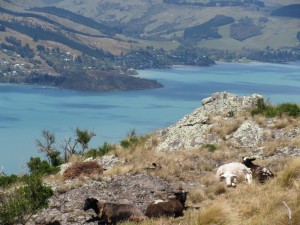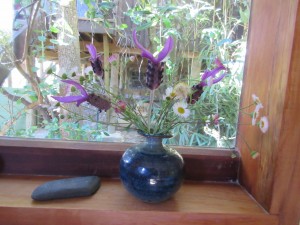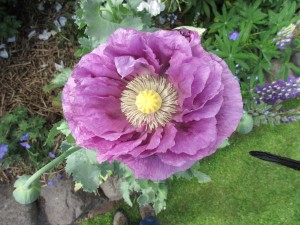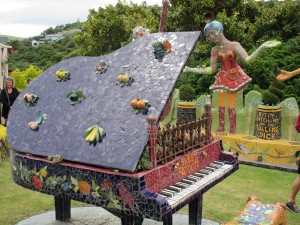 ‘New Zealand’ suggests sheep and hobbits and rugby. It whispers of kiwis – birds and fruit – and an on-going feud with Australia as to who invented the pavlova. It rumbles about earthquakes and volcanoes. It mumbles Sauvignon Blanc and Pinot Noir, and friendly locals with strange vowels. It roars the haka and murmurs moko (tattoos). It tramps through bush and snow, over mountains and around sheep. It purrs about jade and paua shell. It bubbles mud pools and thermal springs. It swims in the Pacific Ocean or the Tasman Sea and cruises through Milford Sound. It coos over the tiny Maui dolphin and the little blue penguin. It builds weatherboard houses and baches (to rhyme with matches) by the beach. It idolizes the iconic VW campervan and its rugby team. It invented bungy jumping, the jet boat and the ski plane. It boasts of Sir Edmund Hillary, votes for women (a world first) and Apirana Ngata, campaigner for Maori rights. It munches on Afghan biscuits and cooks in a hangi (Maori earth oven) or on a sausage sizzling barbecue. It protects native birds, bats and the ancient kauri. It is a land of great natural beauty and greater natural disasters…
‘New Zealand’ suggests sheep and hobbits and rugby. It whispers of kiwis – birds and fruit – and an on-going feud with Australia as to who invented the pavlova. It rumbles about earthquakes and volcanoes. It mumbles Sauvignon Blanc and Pinot Noir, and friendly locals with strange vowels. It roars the haka and murmurs moko (tattoos). It tramps through bush and snow, over mountains and around sheep. It purrs about jade and paua shell. It bubbles mud pools and thermal springs. It swims in the Pacific Ocean or the Tasman Sea and cruises through Milford Sound. It coos over the tiny Maui dolphin and the little blue penguin. It builds weatherboard houses and baches (to rhyme with matches) by the beach. It idolizes the iconic VW campervan and its rugby team. It invented bungy jumping, the jet boat and the ski plane. It boasts of Sir Edmund Hillary, votes for women (a world first) and Apirana Ngata, campaigner for Maori rights. It munches on Afghan biscuits and cooks in a hangi (Maori earth oven) or on a sausage sizzling barbecue. It protects native birds, bats and the ancient kauri. It is a land of great natural beauty and greater natural disasters…
I first read the Hobbit in 1980, before it was set in New Zealand. Then I discovered ‘The Bone People’ at university. Author, Keri Hulme, only ever wrote the one book, but she won the Booker Prize in 1985. I loved it. The dancing, poetic language enticed and enveloped me, and I have dreamed of visiting New Zealand ever since. We just never seemed to be travelling in that direction. Last month I unexpectedly found myself on a flight to Christchurch to visit my best friend from primary school. It was the chance to re-ignite a long-neglected friendship, and to realize a long-held dream.
The weather forecast looked dismal – two days of sunshine followed by a week of rain, hail and cloudy skies – so I had packed my trusty and ancient Gortex raincoat (a garish shade of red) and my umbrella. Luckily the forecast proved totally unreliable: I needed the raincoat only once, the umbrella not at all…
Christchurch is New Zealand’s second-largest city, situated half way down the east coast of the South Island. The city lies at the northern end of the Canterbury Plains, bordered by the Southern Alps to the west and the Pacific Ocean, and is mostly as flat as a freshly ironed tablecloth. Christchurch was carefully planned in a grid pattern with a central square and lots of parks, just like its twin city – my home town – in South Australia, and nothing at all like Manila.
Unfortunately, like Manila, Christchurch was also lying on a fault line, but the only other recorded quakes to cause a major impact were in 1869 and 1870, so no one really worried about it. Then, in September 2010, there was an earthquake in Canterbury of 7.1 magnitude that caused widespread damage, but no fatalities. Everyone breathed with relief. Then, less than six months later, another quake struck the region, which tore the city apart. Almost 200 people were killed and large tracts of the city collapsed or have subsequently had to be demolished. Liquefaction buried many suburbs in sludge and silt. Repairs and rebuilding are ongoing. Empty blocks look like gappy teeth on the cityscape, and many buildings are boarded up as they crumble down. Sadly, the eponymous Christchurch Cathedral may meet the same fate.
impact were in 1869 and 1870, so no one really worried about it. Then, in September 2010, there was an earthquake in Canterbury of 7.1 magnitude that caused widespread damage, but no fatalities. Everyone breathed with relief. Then, less than six months later, another quake struck the region, which tore the city apart. Almost 200 people were killed and large tracts of the city collapsed or have subsequently had to be demolished. Liquefaction buried many suburbs in sludge and silt. Repairs and rebuilding are ongoing. Empty blocks look like gappy teeth on the cityscape, and many buildings are boarded up as they crumble down. Sadly, the eponymous Christchurch Cathedral may meet the same fate.
 On the positive side, a strong sense of community has evolved out of the disaster. Shipping containers are now a feature of the landscape: decorated and redesigned as cafés and shops to help restart the city centre, or planted as barriers along the roadsides to protect drivers and pedestrians from the ongoing fear of rock falls. It gives the city a youthful, quirky and somewhat eccentric feel that is rather endearing. And the creativity and humour in the face of such a catastrophe is really heart-warming.
On the positive side, a strong sense of community has evolved out of the disaster. Shipping containers are now a feature of the landscape: decorated and redesigned as cafés and shops to help restart the city centre, or planted as barriers along the roadsides to protect drivers and pedestrians from the ongoing fear of rock falls. It gives the city a youthful, quirky and somewhat eccentric feel that is rather endearing. And the creativity and humour in the face of such a catastrophe is really heart-warming.
I emerge from the airport into blue skies and sunshine and the wide, straight roads of the western suburbs, lined with neat weatherboard houses. We throw my bags into the boot and head east for the satellite town of Lyttleton, the epicenter of the 2011 earthquake, and a sharp geographical contrast to the Canterbury Plains.
The first British settlers sailed into Lyttleton Harbour in the 1850s, and established the small town of the same name, which clambers up the precipitous sides of the Port Hills from the quay. These steep, rugged hills presented a challenging barrier between the harbour and the new city. For many years the only way into the city was over the hills on the precipitous Bridle Path. Today, the Bridle Path is mostly used by energetic recreational walkers, while road traffic flows underneath, through a 2km tunnel built back in 1964, currently celebrating its 50th anniversary. On the top of the Port Hills, at Mount Cavendish, a scenic lookout perches like a giant eagle’s eerie, housing the Christchurch cable car that drops sharply down the western side of the hill, frightening sheep. The lookout provides a stunning panoramic view across Christchurch, the hills and Lyttleton Harbour, which makes it a great place to catch your breath and grab a bite to eat after the strenuous climb – or the gentle cable car ride. It also proved to be a great place for a little Christmas shopping!
My temporary abode also has the most glorious views from the kitchen window and the broad deck, north and east  across the harbor’s glacier mint waters and west to the bare and craggy hills behind. (On the first of December – the first day of summer in the antipodes – we woke to see snow dusting the top of Mount Herbert like icing sugar.) The garden is full of temperate climate plants, including a prolific little lemon tree, a wisteria and a luxurious veggie patch. The front path weaves through a tunnel of trees like the road to fairyland. A midnight black cat sleeps in my suitcase. And there are wildflowers on my window sill.
across the harbor’s glacier mint waters and west to the bare and craggy hills behind. (On the first of December – the first day of summer in the antipodes – we woke to see snow dusting the top of Mount Herbert like icing sugar.) The garden is full of temperate climate plants, including a prolific little lemon tree, a wisteria and a luxurious veggie patch. The front path weaves through a tunnel of trees like the road to fairyland. A midnight black cat sleeps in my suitcase. And there are wildflowers on my window sill.
The roads in Diamond Harbour twist and turn through the trees, dip and dive into bays, and scramble up the rocky hillsides. Houses seem to cling precariously, like birds’ nests, to the steep slopes. We lurch down a narrow grassy path to the black sandy beach at Pile Bay, crammed with shuttered baches, and watch as a small brown duck paddles into shore and waddles over to inspect these presumptuous human beings who have invaded his realm. He is nicknamed Robert, and he follows us around the headland, trying to pretend it is a coincidence, and he has forgotten all about us, but just happened to be passing the same way. I am the Duck Whisperer. Two days later, I am accosted by Deirdre and George as I lie on the grass by the Heathcote River, who choose to settle near my feet like devoted dogs, tucking their heads under their feathers and snoozing peacefully in the sun.
 We make a trip to Akaroa to admire beautiful gardens on fertile, volcanic soil. It is late Spring and the roses are lush and heavy on their stems, although surprisingly lightly scented. All their energy has gone into the visual: chubby blooms, like Anne Gedes babies, that drag the branches of the exhausted mother bush towards the earth. Lupins and lavender, peonies and pansies, espaliered pears and arum lilies: it is all the pastel colours of an English country garden. Until your eyes are caught by the stately stand of silvery eucalypts, a shady nook enveloped in bottle green, delicately curling ferns, a flamboyant pohutukawa – the native New Zealand Christmas tree – with its scarlet baubles, or the spiky orange blades of the libertia trimming a gravel path. Contrasting floral cultures intertwined.
We make a trip to Akaroa to admire beautiful gardens on fertile, volcanic soil. It is late Spring and the roses are lush and heavy on their stems, although surprisingly lightly scented. All their energy has gone into the visual: chubby blooms, like Anne Gedes babies, that drag the branches of the exhausted mother bush towards the earth. Lupins and lavender, peonies and pansies, espaliered pears and arum lilies: it is all the pastel colours of an English country garden. Until your eyes are caught by the stately stand of silvery eucalypts, a shady nook enveloped in bottle green, delicately curling ferns, a flamboyant pohutukawa – the native New Zealand Christmas tree – with its scarlet baubles, or the spiky orange blades of the libertia trimming a gravel path. Contrasting floral cultures intertwined.
Akaroa was claimed by the British in 1840, snatching it from under the noses of French whalers who had earlier made a deal with local Maoris. The French stayed on anyway, and there are still traces of French heritage in the architecture and on the street signs: Rue Benoit and Rue Balguerie, Rue Jolie and Rue Lavaud. And, apparently, in a local penchant for French wines. Today there is an opportunity to swim with the petite Hector’s dolphin, spot seals and whales, and search for Pohatu penguins. The town is blessed with a broad selection of good cafés and  restaurants, and picturesque weatherboard cottages. And there is a Polish jeweler at the end of the jetty who designs beautifully delicate pieces from paua shell pearls that meld traditional Maori shapes and modernity. Walking tracks will guide you up the creeks and into the hills behind the town. Akaroa Harbour is also a haven for the occasional cruise ships that dwarf the flotilla of sailing boats nestling at the head of the harbor. And the piece de resistance? The Giants Garden, whose terraced lawns and paths and flowerbeds are bejeweled and embedded with bright mosaics: statues, staircases and garden seats that provide a startling contrast to the natural beauty of flowers, trees and the surrounding hills. There is even a grand piano standing proudly on the front lawn of this historic French style house built with New Zealand timber way back in 1880. It is… breath-taking.
restaurants, and picturesque weatherboard cottages. And there is a Polish jeweler at the end of the jetty who designs beautifully delicate pieces from paua shell pearls that meld traditional Maori shapes and modernity. Walking tracks will guide you up the creeks and into the hills behind the town. Akaroa Harbour is also a haven for the occasional cruise ships that dwarf the flotilla of sailing boats nestling at the head of the harbor. And the piece de resistance? The Giants Garden, whose terraced lawns and paths and flowerbeds are bejeweled and embedded with bright mosaics: statues, staircases and garden seats that provide a startling contrast to the natural beauty of flowers, trees and the surrounding hills. There is even a grand piano standing proudly on the front lawn of this historic French style house built with New Zealand timber way back in 1880. It is… breath-taking.
New Zealand is, quite simply, a feast for the senses. I am smitten, just by the little corner I got to explore. I could warble on for pages, but I have to start planning the next trip, so I will leave the rest to your imaginations, or the next installment…

Hello, constantly i used to check web site posts here
early in the break of day, as i love to find out more and more.